Your Journey to a Healthier Life Starts Here
Free Insurance Verification
Verify Your Treatment Coverage
Verify Your Treatment Coverage
Crack Cocaine Treatment combines medically supervised detox, behavioral therapies, and aftercare support to help individuals overcome addiction and achieve long-term sobriety. Here’s what you need to know:
Key Treatment Components:
Crack cocaine is one of the most addictive substances known. It reaches the brain within 10 seconds of being smoked, producing an intense but short-lived high that lasts only about 15 minutes. This rapid cycle drives users to repeat use almost immediately, creating a devastating pattern that can start after just one use.
Statistics paint a sobering picture: in 2021, approximately 24,486 people died from overdoses involving cocaine. In 2022, 1.4 million people met the criteria for cocaine use disorder. Despite decades of intervention, cocaine use has not significantly decreased in the U.S.
But recovery is possible. While withdrawal symptoms like depression, anxiety, and intense cravings are uncomfortable, they are not typically life-threatening. Professional help allows individuals to detox safely and start rebuilding their lives.
At Addiction Helpline America, we connect individuals and families with evidence-based Crack Cocaine Treatment programs custom to their needs. Our addiction specialists are available 24/7 to guide you through every stage of recovery. Seeking help is a brave first step, and we’re here to support you.
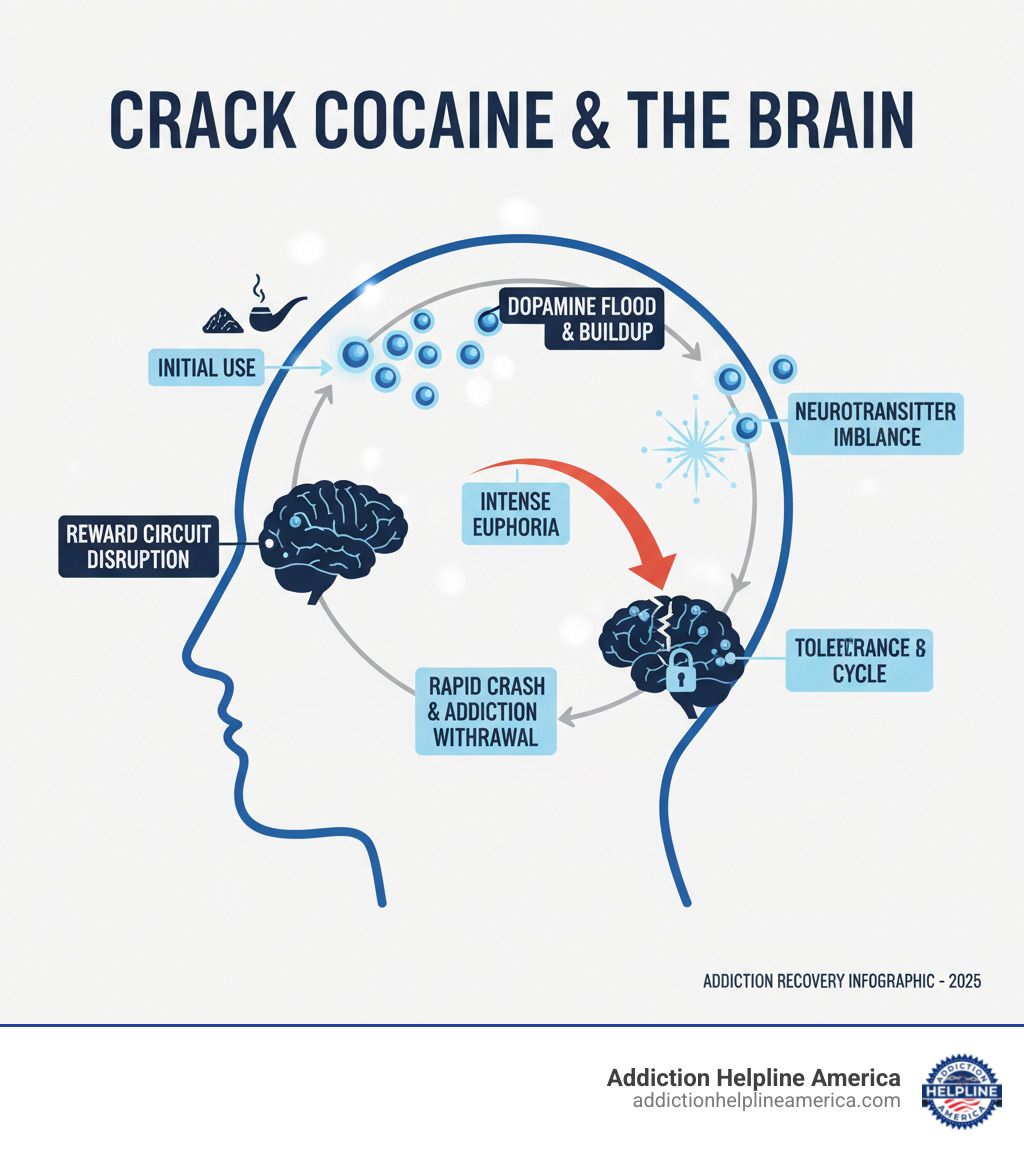
Crack cocaine is a potent, fast-acting form of cocaine. When smoked, it delivers an instant, intense high followed by a severe crash. This cycle drives repeated use, making crack one of the most addictive substances. Recognizing the signs of use, its effects on the brain, and its health consequences is the first step toward seeking Crack Cocaine Treatment.
Recognizing the signs of crack use can save a life. Look for both physical and behavioral changes that may happen gradually before becoming overwhelming.
Physical signs often include:
Behavioral and psychological signs include:
If you see these signs, it’s a clear indicator that professional help is needed. At Addiction Helpline America, we can guide you in finding the right Crack Cocaine Treatment.
Common Street Names for Crack:
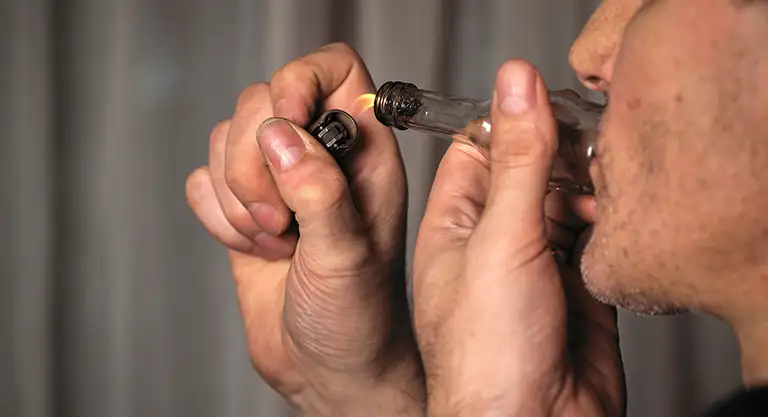
Crack’s addictiveness stems from its powerful effect on brain chemistry. When smoked, it floods the brain with dopamine, the neurotransmitter responsible for pleasure, by blocking its reabsorption. This creates an unnatural, intense euphoria that rewires the brain’s reward circuit to prioritize the drug above all else, leading to compulsive drug-seeking behavior.
After the short-lived high (about 15 minutes), dopamine levels crash, causing severe depression and overwhelming cravings. To cope, the brain reduces its own dopamine production, leading to tolerance. The user then needs more crack just to feel normal. This process also damages decision-making, impulse control, and memory.
Addiction is a chronic brain disease, not a moral failing. Professional Crack Cocaine Treatment is essential to address these deep neurobiological changes through comprehensive, evidence-based care.

Take the first step towards a healthier life! Call now to connect with our compassionate team and start your recovery journey today. Your path to healing awaits!
Our recovery specialists are available 24/7 to provide support, and all calls are confidential and free. Reach out anytime – we’re here to help!
Crack’s addictiveness stems from its powerful effect on brain chemistry. When smoked, it floods the brain with dopamine, the neurotransmitter responsible for pleasure, by blocking its reabsorption. This creates an unnatural, intense euphoria that rewires the brain’s reward circuit to prioritize the drug above all else, leading to compulsive drug-seeking behavior.
After the short-lived high (about 15 minutes), dopamine levels crash, causing severe depression and overwhelming cravings. To cope, the brain reduces its own dopamine production, leading to tolerance. The user then needs more crack just to feel normal. This process also damages decision-making, impulse control, and memory.
Addiction is a chronic brain disease, not a moral failing. Professional Crack Cocaine Treatment is essential to address these deep neurobiological changes through comprehensive, evidence-based care.
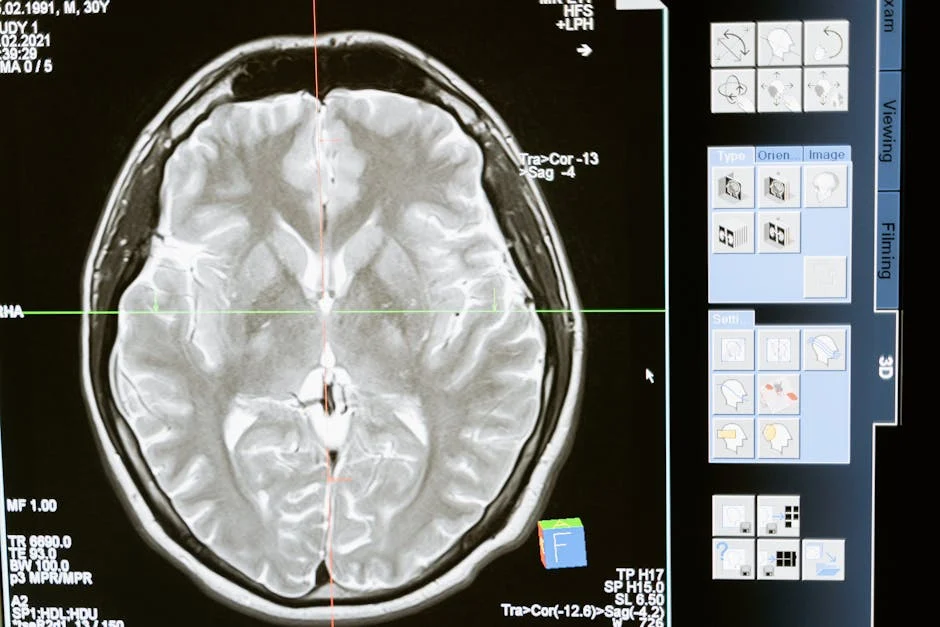
Chronic crack use devastates the body, leading to health consequences that can be permanent or fatal.
These severe health risks underscore the urgency of seeking professional Crack Cocaine Treatment. Early intervention can prevent further damage and dramatically improve long-term health outcomes.
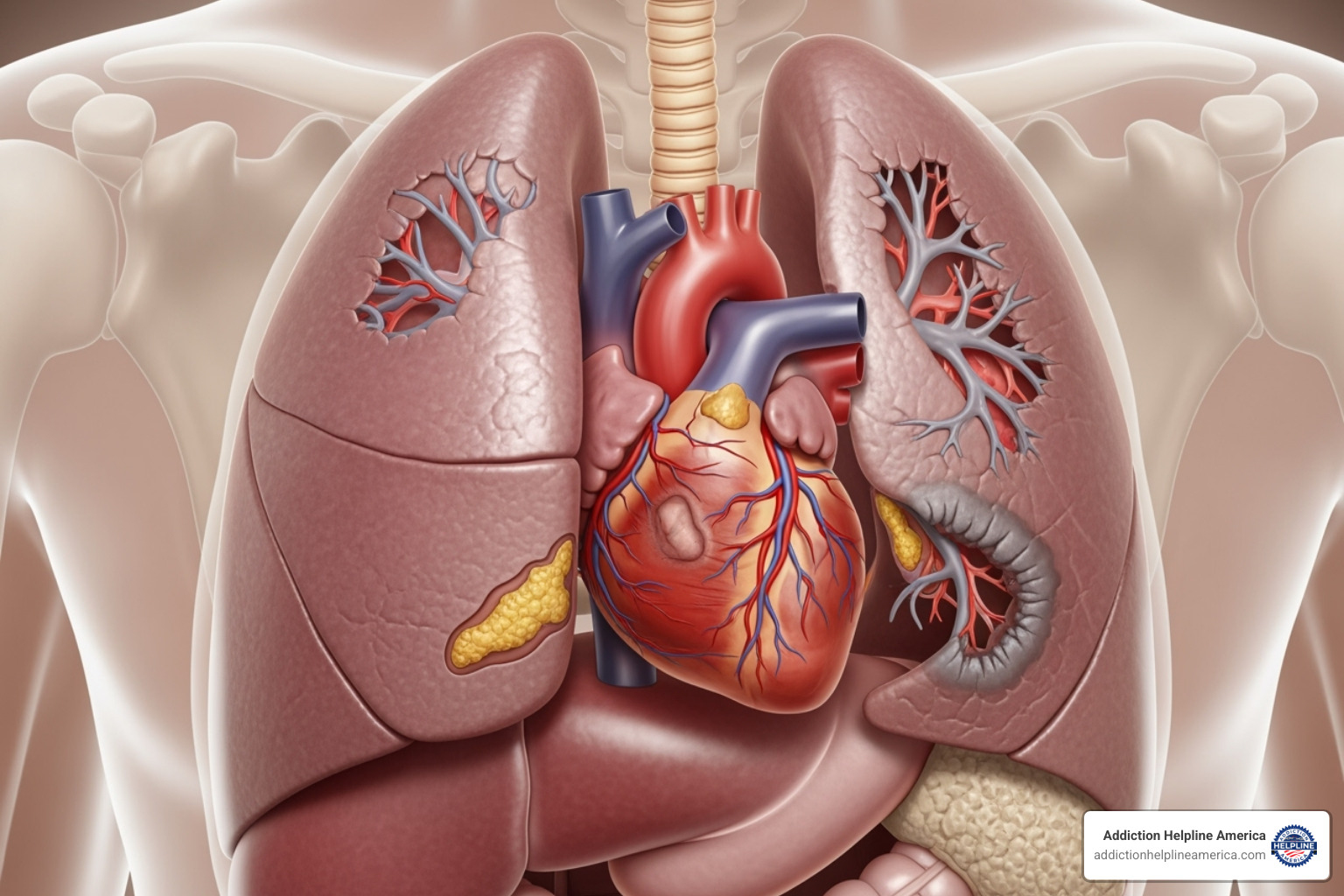
Quitting crack cocaine is an arduous journey, primarily because of the intense physiological and psychological withdrawal symptoms that emerge when use stops.
While not typically life-threatening, crack withdrawal is deeply uncomfortable and distressing, which often drives relapse. The intensity of these symptoms makes quitting without support incredibly difficult. Key symptoms include:
Research indicates that severe withdrawal symptoms are linked to higher dropout rates from treatment, highlighting the need for a structured and supportive detox environment.
The withdrawal timeline varies but generally follows a pattern influenced by the duration of use, metabolism, and overall health.
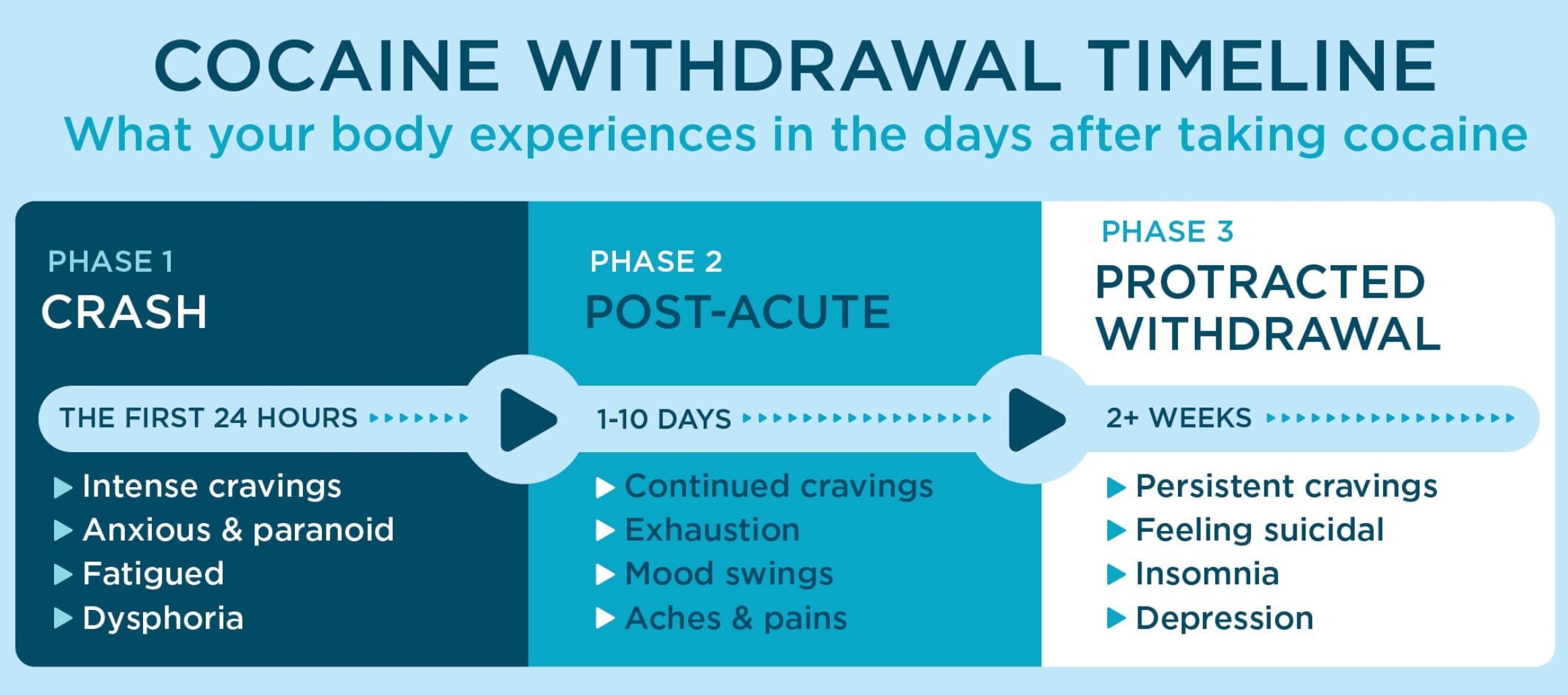
Due to the psychological intensity and risk of severe depression, attempting to quit alone is not advised. Professional support is crucial for safely managing withdrawal. For more details, you can explore scientific research on cocaine withdrawal severity.

Take the first step towards a healthier life! Call now to connect with our compassionate team and start your recovery journey today. Your path to healing awaits!
Our recovery specialists are available 24/7 to provide support, and all calls are confidential and free. Reach out anytime – we’re here to help!
Effective Crack Cocaine Treatment must address physical withdrawal, psychological cravings, and underlying life issues. At Addiction Helpline America, we connect you with comprehensive programs custom to your needs.
Quitting crack alone is extremely difficult due to overwhelming cravings and psychological distress. Medically supervised detox is a critical first step.
While crack withdrawal isn’t usually life-threatening, the severe depression and anxiety can be dangerous. In a detox facility, you receive 24/7 medical monitoring to ensure safety and manage complications. The medical team can provide medications to ease discomfort, such as for anxiety or sleep. This isn’t a cure for addiction, but a way to stabilize you physically and mentally, preparing you for the next stage of rehabilitation.
After detox, rehabilitation helps you build a foundation for a drug-free life. The choice between inpatient and outpatient care depends on your needs.
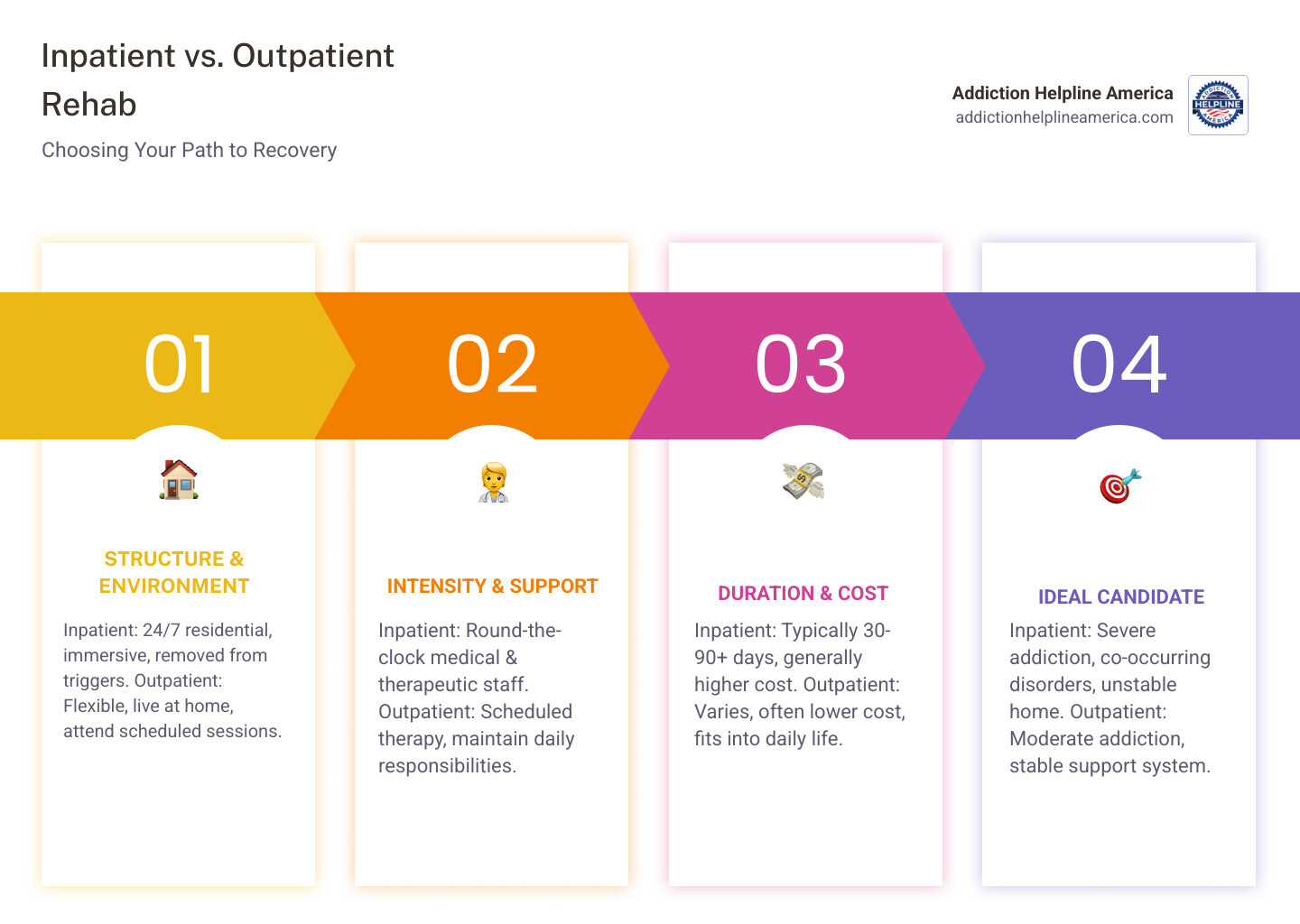
Inpatient rehabilitation provides a highly structured, 24/7 environment, removing you from triggers and daily stressors. Lasting 30 to 90 days, it’s ideal for those with severe addiction, co-occurring mental health issues, or an unstable home environment.
Outpatient rehabilitation offers flexibility, allowing you to live at home while attending scheduled therapy. It’s suitable for those with less severe addiction and a strong support system. Options range from standard outpatient to more structured Intensive Outpatient Programs (IOP) and Partial Hospitalization Programs (PHP).
Neither is “better”—it’s about the right fit. We can help you assess your situation to find the program that gives you the best chance of success.
With no FDA-approved medications for crack addiction, behavioral therapies are the cornerstone of treatment. These evidence-based approaches teach practical skills to break the patterns of addiction.
These therapies are proven effective, as shown in evidence for behavioral therapies.
A major challenge in Crack Cocaine Treatment is the lack of any FDA-approved medications specifically for cocaine addiction. This means behavioral therapies remain the primary treatment.
However, research is ongoing. Some medications approved for other conditions are sometimes used “off-label” to help manage symptoms like anxiety or fatigue during withdrawal. These may include drugs like propranolol, baclofen, or modafinil. Innovative approaches like a cocaine vaccine (TA-CD) are also under investigation, offering hope for future treatment options.
For now, recovery relies on proven therapeutic approaches. We connect clients with programs that use the most effective, evidence-based methods available. You can learn more about new medications for cocaine dependence research.
Recovery is a long-term journey that begins, not ends, with treatment. Sustaining sobriety requires ongoing support and resources. At Addiction Helpline America, we guide people through this entire process, from initial treatment to lasting recovery.
There is no one-size-fits-all Crack Cocaine Treatment. The best plan is one custom to your unique situation. Our team at Addiction Helpline America helps you find the right fit by considering several factors:
You don’t have to make this decision alone. Our confidential, 24/7 helpline is here to guide you.
Completing a rehab program is a major achievement, but the real work of recovery begins when you return to daily life. Aftercare is the foundation for maintaining sobriety.
Key components of a strong aftercare plan include:
Addiction impacts the entire family, and family support is a powerful tool in recovery. Here’s how loved ones can help:
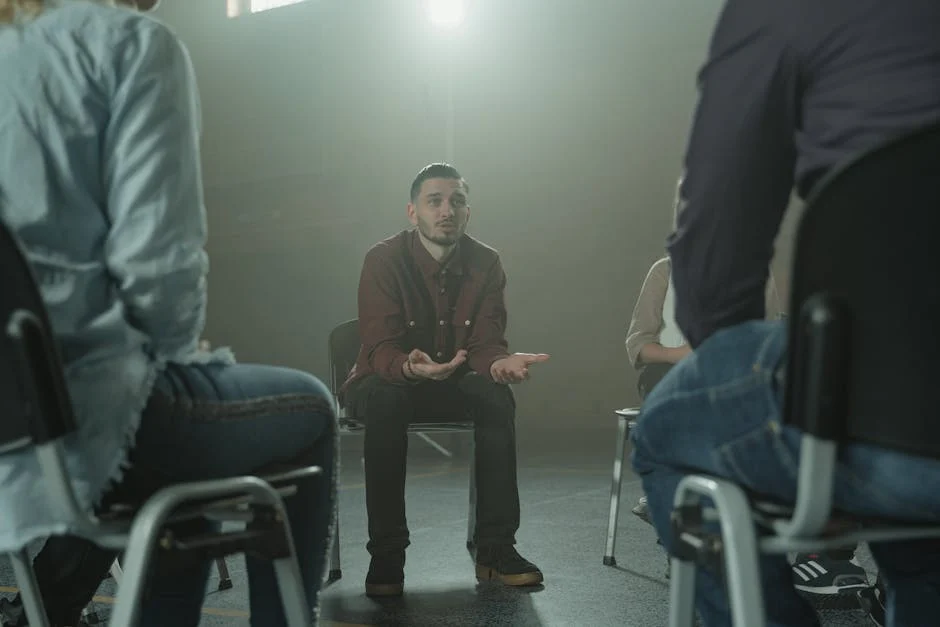
Crack cocaine addiction is a formidable challenge, but recovery is possible, and you don’t have to do it alone.
This guide has outlined the path to recovery through Crack Cocaine Treatment. It starts with understanding how the drug rewires the brain and navigating the difficult withdrawal period with medically supervised detox. The core of treatment lies in behavioral therapies like Cognitive-Behavioral Therapy and Contingency Management, which provide the tools to rebuild your life.
Lasting recovery depends on strong aftercare, including ongoing therapy, support groups like NA or CA, and a supportive home environment. It’s a journey, and every day of sobriety is a victory.
At Addiction Helpline America, we see lives transform when people get connected to the right help. Our team is available 24 hours a day, 7 days a week to provide free, confidential guidance and connect you with a specialized treatment program that fits your unique needs. You don’t need all the answers—you just need to be willing to reach out.
The future you’re hoping for is within reach. Thousands of people have walked this path before you, and they’re living proof that healing is possible.
Take that brave first step today.
Are you or a loved one struggling with addiction? Call today to speak to a treatment expert.
Calls to any general helpline will be answered or returned by one of the treatment providers listed, each of which is a paid advertiser:
Our helpline is available 24 hours a day, 7 days a week at no cost to you and with no obligation for you to enter into treatment. We are committed to providing support and guidance whenever you need it.
In some cases, Addiction Helpline America charges our verified partner a modest cost per call. This fee helps us cover the costs of building and maintaining our website, ensuring that we can continue to offer this valuable service to those in need.
Calls to the general helpline will be answered or returned by one of the listed treatment providers, all of whom are paid advertisers.
By using the helpline, you agree to the terms of use. We do not earn any commission or fee based on the treatment provider selected by the caller, and there is no obligation to pursue treatment.
This service is not affiliated with Alcoholics Anonymous World Services, Inc.